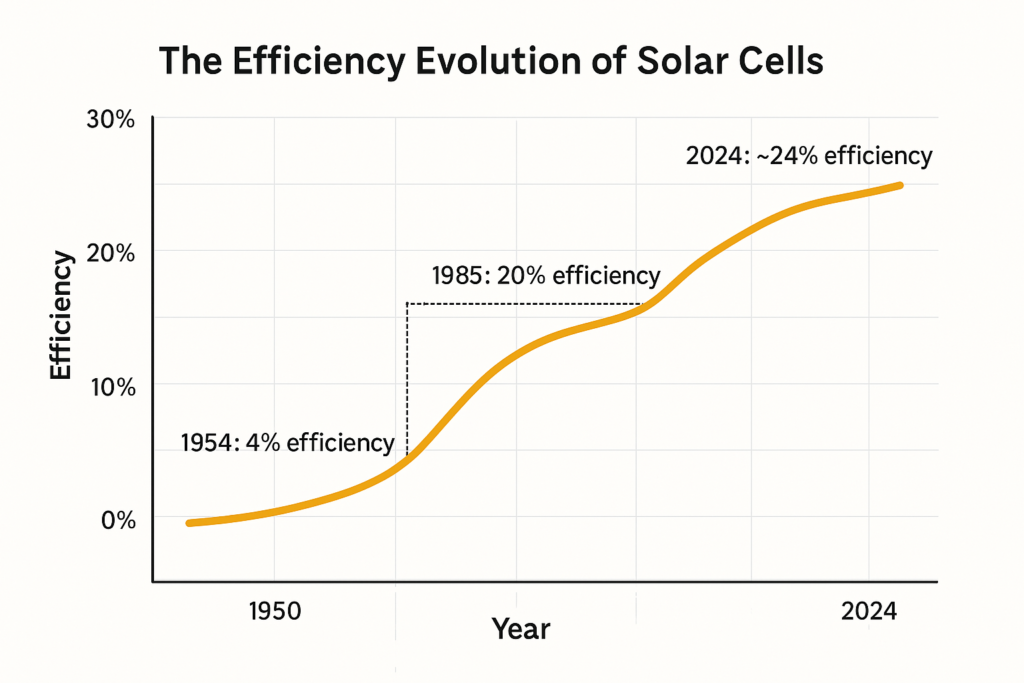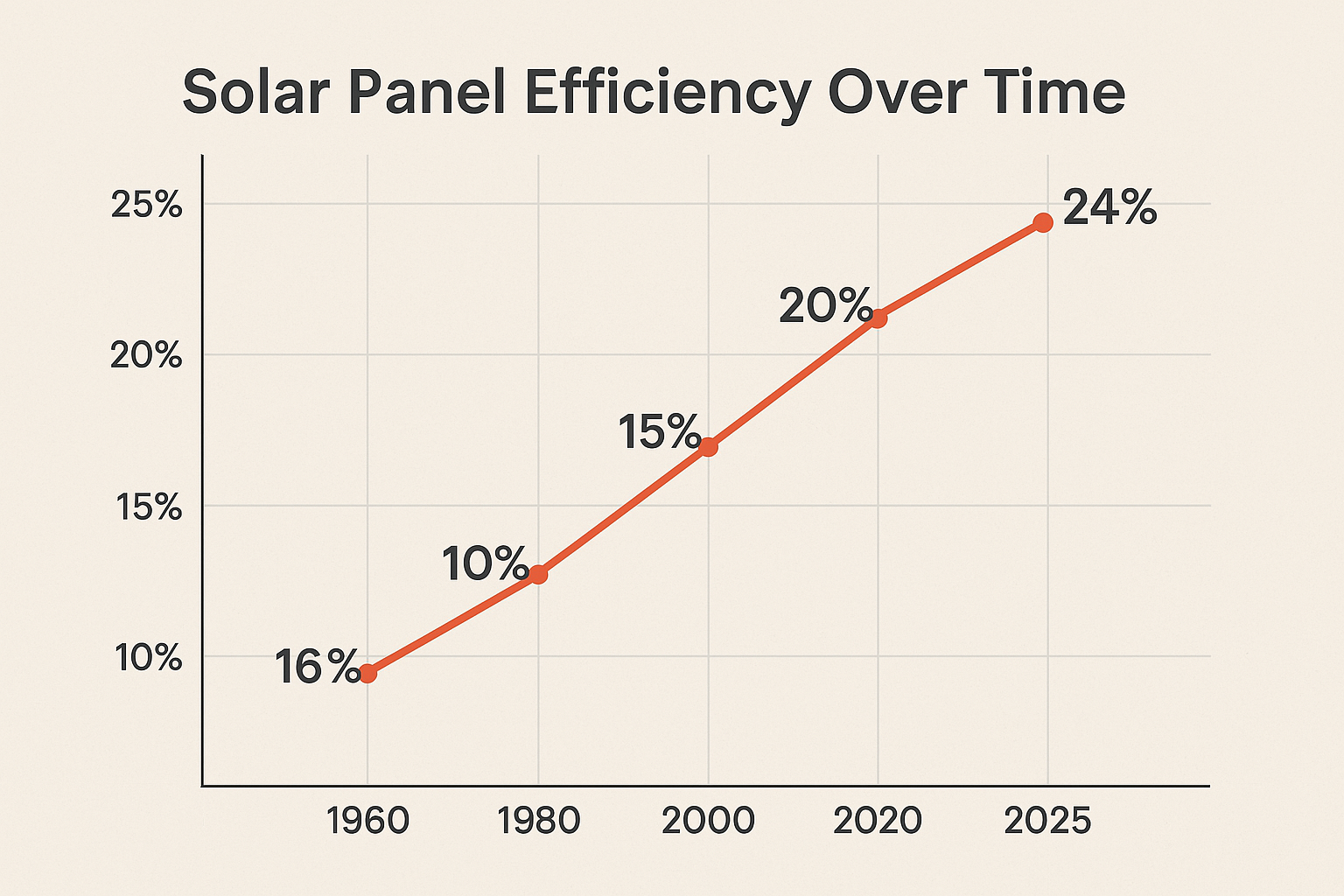🏆 ✅ Quick Highlights: Solar Panel Evolution at a Glance
- 📅 1839 – French physicist Edmond Becquerel discovers the photovoltaic effect, laying the foundation of solar technology.
- ⚡ 1954 – Bell Labs creates the first practical silicon solar cell with 4% efficiency.
- 📈 1985–1999 – Solar efficiency crosses 20%, with lab records reaching over 33% by the late 1990s.
- 🔬 2025 (Today) – Commercial solar panels now achieve 20–24.1% efficiency, with mass adoption worldwide.
- 🌞 Emerging Technologies – Perovskite cells & Building-Integrated Photovoltaics (BIPV) are reshaping the future of solar.
- 🔋 Storage & AI – Advances in battery storage and AI-based energy management are making solar power smarter and more reliable.

Solar Panel Evolution Explained: What’s Changed & What’s Next?
Solar energy has emerged as a cornerstone of global renewable energy efforts. With the urgent need to reduce carbon emissions and combat climate change, solar power offers a clean, abundant, and increasingly cost-effective solution. Over the years, solar panel technology has undergone significant transformation—from the discovery of the photovoltaic effect to the development of highly efficient modern panels. In this blog post, we explore the evolution of solar panels, highlight key historical milestones, assess the current state of the technology, and preview exciting innovations on the horizon.
Historical Timeline: The Roots of Solar Power
The journey of solar panels began in 1839 when French physicist Edmond Becquerel discovered the photovoltaic effect—the foundational principle of solar cells. This effect describes how certain materials generate an electric current when exposed to light.
In 1881, American inventor Charles Fritts created the first solar panel using a thin layer of gold over selenium. Though these early panels were inefficient, they marked the beginning of solar technology.
A major breakthrough came in 1954 when researchers at Bell Labs—Daryl Chapin, Calvin Fuller, and Gerald Pearson—developed the first practical silicon solar cell, achieving an efficiency of 4%. This innovation paved the way for solar panels in space exploration and, later, terrestrial applications.
Over subsequent decades, researchers and engineers worked to improve solar cell efficiency. By the 1970s, solar power costs began to decline, making it viable for remote locations without grid electricity.
In 1985, the University of New South Wales in Australia achieved a milestone by developing a solar cell with 20% efficiency. Further advancements followed, and by the late 1990s, laboratory efficiencies exceeded 30%. For instance, in 1999, the National Renewable Energy Laboratory (NREL) and SpectroLab Inc. created a solar cell with 33.3% efficiency under concentrated sunlight.
In 2016, the University of New South Wales set a new record with a 34.5% efficient solar cell under laboratory conditions.
As of 2025, commercial solar panels typically achieve efficiencies between 20% and 24%, with some premium models reaching 24.1%. This remarkable progress has made solar energy more accessible and efficient than ever before.
Current State: Solar Power in 2025
In 2025, the solar industry is experiencing unprecedented growth. According to the Solar Market Insight Report by the Solar Energy Industries Association (SEIA), the United States installed 50 gigawatts (GW) of new solar capacity in 2024, accounting for 66% of all new electricity-generating capacity added to the grid. This surge is driven by declining costs, supportive policies, and the environmental benefits of solar energy.
Domestically, solar module manufacturing capacity has increased by 190%, surpassing 50 GW in early 2025. This expansion is largely concentrated in southern states like Texas and Georgia.
On the technology front, the most efficient commercially available solar panels now achieve 24.1% efficiency, as seen in offerings from manufacturers like Maxeon. Other producers, such as Aiko, have delivered panels with 24% efficiency.
These efficiency improvements mean solar panels can generate more electricity from the same amount of sunlight, making them more practical and cost-effective for residential and commercial use.
Future Trends and Innovations
Looking ahead, several exciting trends and innovations promise to shape the future of solar panels.
One of the most promising developments is the rise of perovskite solar cells. Made from materials with a unique crystal structure, these cells offer higher efficiencies and lower production costs compared to traditional silicon-based cells. Researchers predict perovskite cells could exceed 30% efficiency, potentially revolutionizing the solar industry.
Another significant trend is the integration of solar technology into building materials, known as Building-Integrated Photovoltaics (BIPV). This approach embeds solar cells into windows, roof tiles, and facades, enabling buildings to generate electricity without the need for traditional panels. BIPV not only enhances aesthetics but also maximizes energy production by utilizing available surfaces.
Advances in energy storage are also critical to solar’s future. Improved battery technologies, such as lithium-ion and emerging solid-state batteries, will allow solar energy to be stored more efficiently, ensuring a reliable power supply even when the sun isn’t shining.
Additionally, the integration of artificial intelligence (AI) and smart systems is optimizing solar energy management. AI can predict energy production, manage grid integration, and enhance the overall efficiency of solar power systems.
Finally, the solar market is expected to continue its rapid growth. Projections suggest that U.S. solar capacity could reach 377 GW by 2028, powering 65 million homes. This expansion will be fueled by ongoing cost reductions and supportive government policies.
Conclusion
The evolution of solar panels—from their humble beginnings to today’s highly efficient systems—demonstrates human ingenuity and the relentless pursuit of sustainable energy solutions. Looking forward, innovations like perovskite cells, BIPV, advanced energy storage, and AI integration promise to enhance solar power’s capabilities and adoption. By staying informed about these developments, individuals and businesses can make educated decisions about integrating solar energy, contributing to a cleaner, more sustainable world.
